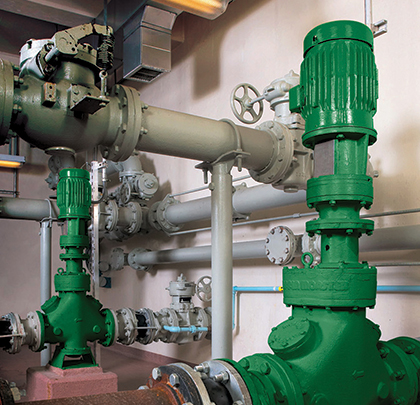Septage, or septic tank sludge, receiving creates extra demands on a water resource recovery facility’s (WRRF) equipment and treatment process. Dozens of septage trucks bring in vast amounts of debris from septic tanks, portable toilets, local restaurants and other businesses. The thousands of gallons of waste coming in from these trucks also includes rocks, rags, clothing, scum and grease. If not properly managed from the beginning, this influx of septage can disrupt the treatment process and damage downstream pumps, pipes and valves.
One WRRF in Colorado underwent a dramatic upgrade to their septage receiving area, incorporating smart control and storage features, as well as a powerful and efficient waste reduction solution in the form of three 30K in-line Muffin Monsters® sewage grinders from JWC Environmental. The result is a clean, efficient and automated system with full pump and pipeline protection.
OUTDATED AND UNDERPERFORMING
The original septage receiving area at the Las Vegas Street Water Resource Recovery facility in Colorado Springs, Colorado, was essentially an open pit with a bar screen. Septage trucks would deliver the waste and dump it into the pit, where it would sometimes stagnate and start to cause odor problems. The septage would also flow through the facility at random intervals, occasionally overloading the system and causing clogs and blockages. Facility managers were frustrated by the inefficiency of the septage receiving area, and began looking at options to enhance their system and make it more productive and profitable.
REVITALIZING THE SYSTEM
Colorado Springs Utilities worked with Integra Engineering to develop and construct a state-of-the-art receiving building. The upgrade outfitted the septage receiving area with intelligent monitoring capabilities and an updated pretreatment system, helping operators gain control of the 30,000 gallons (113,562 liters) of septage rolling into their facility daily. Integra designed the new building to store, condition and then transfer the septage at optimal times to avoid overloading the facility. Engineers added several unique systems into the building—quick-connect hose couplers, transfer and mixing pumps, PVC-lined holding tanks, special storage tanks for contaminated waste and three dual-shafted Muffin Monster grinders for rugged debris reduction.
GRINDERS MATCH POWER TO TASK
Integra selected the 30K in-line Muffin Monster grinders after researching the available debris reduction solutions on the market. The engineers determined that the innovative design and performance of the Muffin Monster grinders were best suited for the demanding septage needs at the Las Vegas Street WRRF. The dual-shafted grinders easily shred through rags, clothing, wood and rocks into tiny, manageable particles that pass through pipes and pumps without clogging the equipment or compromising flow. The in-line units quickly adapt into existing pipelines, saving on installation time and eliminating the need for complete system retrofit.
The grinders are positioned in front of the transfer pumps to catch and grind the debris as it entered in through the system. This offered optimal protection to the transfer pumps, as well as the rest of the equipment downstream of the facility.
SEPTAGE RECEIVING MADE SIMPLE
Today, trucks arriving at the Las Vegas Street WRRF are controlled by a card access and billing system that records the trucking company, meters the flow and takes a pH reading of their septage content. After swiping an access card, the driver connects his truck to the coupler and starts unloading. Flow enters the specially designed storage tanks with PVC lining, where mixing pumps provide circulation in order to keep grit, scum and grease suspended.
Staff at the control center can transfer septage manually or utilize an automated program that pumps material into the facility during low-flow periods. Digital instrumentation monitors pH level, lower explosive limit and liquid level of the septage mix. The septage receiving building also allows operators flexibility in intercepting, holding and transferring contaminated waste in order to maintain proper organic levels.
These updates, along with the inclusion of the Muffin Monster grinders, has resulted in a successful, streamlined system that deals with incoming septage while ensuring that equipment is protected throughout the process. ◆
Kevin Bates is the director of global marketing for JWC Environmental. Mr. Bates brings more than twenty years of experience leading marketing, product management and engineering teams in a variety of global companies. His strong background industrial products has been developed in multiple industries including oil and gas, automotive, construction and mining. Prior to joining JWC, Kevin Bates held leadership positions with MMFX Technologies and at Boart Longyear. For more information, visit www.jwce.com.
____________________________________________
MODERN PUMPING TODAY, August 2015
Did you enjoy this article?
Subscribe to the FREE Digital Edition of Modern Pumping Today Magazine!
![]()


